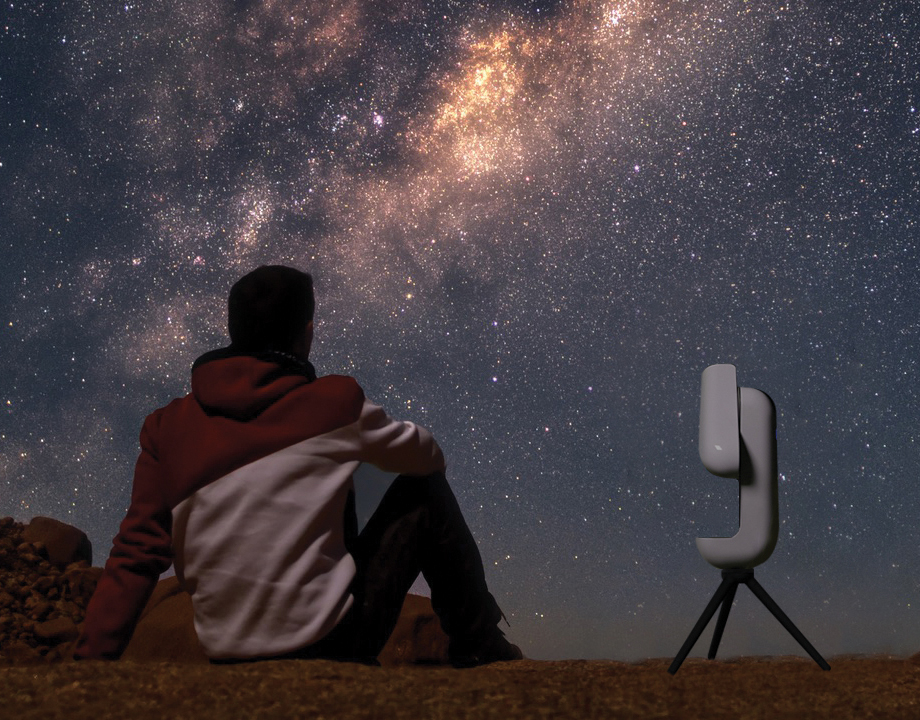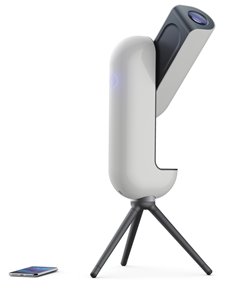Automated Star Gazing
Automated Star Gazing


An app-driven telescope searches the night sky.
The essential tool for astronomy hobbyists, of course, is an optical device to view the night sky. Telescopes are essential, although binoculars also may offer a satisfying experience for less money. Now, there is another option, an “observation station” that is a hybrid between a smart telescope and camera that works with an app to automatically set up, observe, and record the night sky on a smartphone or tablet.
Vespera, manufactured by Montpellier, France-based Vaonis, includes what the company claims is a unique quadruplet 50-mm lens of lanthanum glass, with no distortion, chromatic aberration, or astigmatism. It uses a new sensor designed by Sony for extreme low light, with a 1/28 format and a 2.9 μm pixel size.
Software embedded in a Raspberry Pi allows the device to initialize itself and point and track any object and send images to a mobile device.
Vaonis calls the technology “image live stacking,” which merges short exposures together to provide color and details of the chosen object. Depending on the object’s brightness, position in the sky, and degree of air quality, it can take anywhere from five minutes to an hour to produce the proper image, said Stephanie Simpraseuth, Vaonis’ marketing manager.
Recommended for You: An Automated Hygiene Management System
Vespera is a smaller version of Stellina, the firm’s original, larger device, and uses the same technology. It was developed by Vaonis’ CEO and founder, Cyril Dupuy, who has a degree in optics and aerospace.
The devices do not need a completely dark sky to operate, but can be used from nautical twilight when the sun is six degrees below the horizon. They generally initialize in five minutes or less, compared to an hour for a standard telescope.
Standard equipment requires accurate synchronization with the orientation and rotation of the sky based on time and geographical location. The mount axis must also be properly aligned before it can calculate position of the stars and activate motors to point properly.
Editor's Pick: Portable Docking for Autonomous Underwater Vehicles
Vespera and Stellina do all of that automatically. Geolocation and time are retrieved from the connected device’s GPS, although it can also be loaded manually. To determine orientation between the device and sky position, it uses the astrometric calibration method, comparing the starfield within the telescope’s view and an internal database to identify the targeted area.
After capturing an image of bright stars, the device’s computer analyzes it to determine star patterns and compares it with an internal database to find a match. It follows the rotation of the earth by continuously activating motors on the two axes of Vespera, and a third on Stellina.
Test Your Knowledge in our Quiz: What is AI?
Both devices have an integrated automatic focus. The company claims it is the only consumer telescope to offer the feature. Standard telescopes are focused manually using different methods or through checking star differentiation spikes.
The company recommends initializing the telescope through a smartphone to retrieve date, time, and geographical location and then switch to a tablet using the app to view images on a larger screen. Initialization can be done with a tablet, but time and geographical information generally must be loaded manually because most tablets are not fitted with GPS. An observer can select any target in the app or enter specific celestial coordinates and the device will point to it automatically.
John Kosowatz is senior editor.
Vespera, manufactured by Montpellier, France-based Vaonis, includes what the company claims is a unique quadruplet 50-mm lens of lanthanum glass, with no distortion, chromatic aberration, or astigmatism. It uses a new sensor designed by Sony for extreme low light, with a 1/28 format and a 2.9 μm pixel size.
Software embedded in a Raspberry Pi allows the device to initialize itself and point and track any object and send images to a mobile device.
Vaonis calls the technology “image live stacking,” which merges short exposures together to provide color and details of the chosen object. Depending on the object’s brightness, position in the sky, and degree of air quality, it can take anywhere from five minutes to an hour to produce the proper image, said Stephanie Simpraseuth, Vaonis’ marketing manager.
Recommended for You: An Automated Hygiene Management System
Vespera is a smaller version of Stellina, the firm’s original, larger device, and uses the same technology. It was developed by Vaonis’ CEO and founder, Cyril Dupuy, who has a degree in optics and aerospace.
The devices do not need a completely dark sky to operate, but can be used from nautical twilight when the sun is six degrees below the horizon. They generally initialize in five minutes or less, compared to an hour for a standard telescope.
Standard equipment requires accurate synchronization with the orientation and rotation of the sky based on time and geographical location. The mount axis must also be properly aligned before it can calculate position of the stars and activate motors to point properly.
Editor's Pick: Portable Docking for Autonomous Underwater Vehicles
Vespera and Stellina do all of that automatically. Geolocation and time are retrieved from the connected device’s GPS, although it can also be loaded manually. To determine orientation between the device and sky position, it uses the astrometric calibration method, comparing the starfield within the telescope’s view and an internal database to identify the targeted area.
After capturing an image of bright stars, the device’s computer analyzes it to determine star patterns and compares it with an internal database to find a match. It follows the rotation of the earth by continuously activating motors on the two axes of Vespera, and a third on Stellina.
Test Your Knowledge in our Quiz: What is AI?
Both devices have an integrated automatic focus. The company claims it is the only consumer telescope to offer the feature. Standard telescopes are focused manually using different methods or through checking star differentiation spikes.
The company recommends initializing the telescope through a smartphone to retrieve date, time, and geographical location and then switch to a tablet using the app to view images on a larger screen. Initialization can be done with a tablet, but time and geographical information generally must be loaded manually because most tablets are not fitted with GPS. An observer can select any target in the app or enter specific celestial coordinates and the device will point to it automatically.
John Kosowatz is senior editor.




